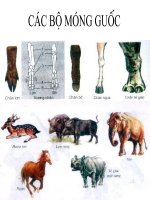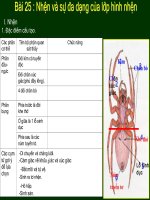Tải Giáo án tiếng Anh lớp 9 Tuần 1 sách mới - Giáo án điện tử môn tiếng Anh 9 theo tuần
Bạn đang xem bản rút gọn của tài liệu. Xem và tải ngay bản đầy đủ của tài liệu tại đây (103.39 KB, 6 trang )
<span class='text_page_counter'>(1)</span><div class='page_container' data-page=1>
<b>GIÁO ÁN TIẾNG ANH LỚP 9 </b>
<b> TRỌN BỘ</b>
<b>NĂM HỌC 2019 - 2020</b>
<b>Period 1 </b> <b>Week 1</b>
<b>REVISION</b>
<b>I. Aims</b>
Practice in the verb tenses, passive, indirect speech, ....
<b>II. Objectives</b>
Ss practise doing exercises.
<b>III. Materials</b>
- Text book
- Board, chalk,...
<b>IV. Anticipated problems</b>
Weak students may get confused with the present perfect.
<b>V. Procedure</b>
<b>1. Warmer</b>
- Greeting.
- Checking attendance.
- Asking for the teaching date.
<b>2. Revision</b>
- During new lesson.
<b>3. New lesson</b>
<b>Homework</b>
- Prepare for the next lesson: Unit 1: Getting started.
Period: 2 Week: 1
<b>Unit 1: LOCAL ENVIRONMENT</b>
<i><b>Lesson 1 - GETTING STARTED: A visit to a traditional craft village</b></i>
<b>I. OBJECTIVES: By the end of this Unit, students will be able to:</b>
</div>
<span class='text_page_counter'>(2)</span><div class='page_container' data-page=2>
<b>II . PREPARATION: sub -board, pictures, cassette </b>
<b>III. PROCEDURES: </b>
<b>Teacher’s and students’ activities</b> <b>Content</b>
<b>Activity 1: </b>
-Ask Ss to open their books and look at the picture and the
phrase under GETTING STARTED. Ask them some
questions:
"Who and what can you see in the picture?"
"Where are they?"
"What do you think the people in the picture are talking
about?"
-Ss answer the questions as a class. If they mention 'Bat
Trang', elicit what they know about this village.
-Play the recording and have Ss follow along. After that, Ss
can compare their answers with the information in the
dialogue and add some more details to their answers.
a/.Ss work independently to find the words with the given
meanings in the dialogue. Allow Ss to share their answers
before asking them to discuss as a class. Remember to ask
Ss to read out the lines in the dialogue that contain the
words. Quickly write the correct answers on the board.
-Have Ss look at the Watch out! box and quickly read the
information. Tell them that there are some similar
expressions such as 'as far as I can remember', 'as far as I
can see', or 'as far as I can tell'.
b/.Have Ss read the questions to make sure they understand
them. Ask them firstly to answer the questions without
reading the dialogue again. Ss exchange their answers with
a classmate. Now ask them to check their answers by
reading the dialogue again. Ask for Ss' answers.
<b>Activity 2: </b>
-Have Ss look at the pictures. Tell Ss that in the box are
1. craft
2. set up
3. take over
4. artisans
5. attraction
6. specific region
7. remind
8. look round
1.They are at Phong’s
grand-parents’ workshop in Bat
Trang
2. It’s about 700 years old.
3. His great-grandmother did.
4. buy things for their house
and make pottery themselves
there.
5. It’s in Hue.
</div>
<span class='text_page_counter'>(3)</span><div class='page_container' data-page=3>
some traditional handicrafts of different regions in Viet
Nam. Ss match these handicrafts with the pictures. Ss
compare their answers in pairs before giving their answers
to T:
<b>Activity 3: </b>
-Tell Ss to complete the sentences with the words/phrases in
The complete sentences will give Ss information about the
places where the handicrafts are made. Call on two Ss to
write their answers on the board. Confirm the correct
answers.
-If time allows, T may organise a short activity to check Ss'
short-term memory. Have -Ss close their books. Point at
each of Ss' answers on the board and quickly Ss have to call
out the place where this handicraft is made. Ss can also be
asked to share any other places that produce these
handicrafts.
<b>Activity 4: </b>
a/Ss work in pairs to do the quiz. The pair which has the
answers the fastest is invited to read out their answers.
Elicit feedback from other pairs. Confirm the correct
answers.
b/Ss work in groups to write a similar quiz about places of
interest. Set a time limit of about five to seven minutes.
When time is up, ask the first group to read out a question
in their quiz. Ss from other groups give the answer. The
group confirms the correct answer. The second group then
reads out a question in their quiz. This question should be
different from the one of the first group. Continue the
activity until all the groups have read out all of their
questions or when time is up.
A. paintings B. drums
C. marble sculptures D.
pottery
E. silk F. lacquerware
G. conical hats H. lanterns
1. conical hat
2. lanterns
3. silk
4. paintings
5. Pottery
6. marble sculptures
1. park
2. museum
3. zoo
4. beach
5. beauty spot
<b>IV- HOMEWORK:</b>
</div>
<span class='text_page_counter'>(4)</span><div class='page_container' data-page=4>
-Write new words then learn them by heart.
-Copy the exercise into notebooks.
-Prepare <b>A CLOSER LOOK 1</b>
Period: 3 Week: 1
<b>Unit 1: LOCAL ENVIRONMENT</b>
<i><b>Lesson 2 – A CLOSER LOOK 1</b></i>
<b>I. OBJECTIVES: By the end of this Unit, students will be able to:</b>
Use the lexical items related to traditional crafts and places of interest in an
area
Say sentences with correct stress on the content words
<b>II . PREPARATION: sub -board, pictures, cassette </b>
<b>III. PROCEDURES: </b>
<b>Teacher’s and students’ activities</b> <b>Content</b>
<b>Activity 1: </b>
-Ss work individually to do this exercise and then
compare their answers with a classmate. Elicit the
answers from Ss and quickly write them on the
board. Do not confirm the correct answers at this
stage. Have Ss explain the meaning of each verb in
English or Vietnamese. Correct Ss' explanations
when needed. The two verbs cast and mould are
quite difficult, so make sure that Ss understand
them: - cast: shape hot liquid metal, etc. by pouring
it into a container - mould: shape a soft substance
into a particular form or object by pressing it or by
putting it into a mould Now have Ss look at their
answers on the board and say if these are correct..
</div>
<span class='text_page_counter'>(5)</span><div class='page_container' data-page=5>
<b>Activity 2:</b>
a/The purpose of this exercise is to help Ss
understand more deeply and use the verbs correctly
to talk about producing and creating crafts. Ss work
in pairs to do the exercise. Check the answers as a
class. If time allows, have Ss make sentences.
b/ This activity will help Ss to manipulate the verbs
as they are not all regular. Have Ss do the activity,
then call two Ss to write their answers on the board.
Elicit feedback from other Ss. Confirm the correct
answers.
-Draw Ss' attention to the Watch out! box. Ask Ss to
give example sentences with the verb to make.
<b>Activity 3:</b>
-Organise a competition for this activity. Ss work in
groups of five or six. Set a time limit of five
minutes. T may prepare some large pieces of paper
for the groups to write their answers on. Ss write
down as many places of interest in the word web as
possible. The group with the most places is the
winner. The winning group presents their
words/phrases. Other groups tick the similar
words/phrases they have and add more if they can. If
time allows, T may ask Ss to explain why they think
the places are entertaining, cultural, educational, or
historical.
<b>Activity 4:</b>
Ss individually do the exercise. Check their answers
as a class and confirm the correct ones.
<b>Activity 5:</b>
a/Have Ss read the five sentences and underline the
words they think are stressed. Elicit answers from
1.b
2.d
3.e
4.a
5.f
6.c
2. cast; cast
3. wove; woven
4. embroidered; embroidered
5. knitted; knitted
6. moulded; moulded
Entertaining: cinema, theatre…
Cultural: opera house, museum…
Educational: library, museum…
Historical: temples, craft village…
1. historical 2. attraction
3. exercise 4. traditional
5. culture 6. handicrafts
S1: craft, village, lies, river, bank
S2: painting, embroidered
S3: what, region, famous
</div>
<span class='text_page_counter'>(6)</span><div class='page_container' data-page=6>
Ss. Do not confirm the correct answers. Now ask Ss
to read the four questions and make sure they
understand them. Ask Ss to listen to the speaker
read the sentences and at the same time check
whether their answers are correct. Tell them that this
is actually the first question and other questions can
be answered after listening. Ss discuss their answers
to the four questions in pairs.
b/Call some Ss to give the answers and give
feedback. Play the recording again for Ss to repeat
the sentences.
-Have Ss read the information in the box to
remember the content of the lesson.
<b>Activity 6:</b>
a/Ss do this exercise individually and compare their
answers with a classmate.
b/Play the recording for Ss to check their answers
and practise reading the sentences. Call some Ss to
give the answers and read the sentences. Give
correction if needed.
S5: famous, artisans, carved, table,
beautifully
2. They are: nouns, verbs,
adjectives, adverbs, WH-question
words, and negative auxiliaries.
4. They are: articles, prepositions,
pronouns and possessive adjectives.
S1: Art, Museum, popular, place,
interest, city
S2: cinema, attract, youngsters
S3: artisans, would, clay, make,
traditional, pots
S4: Where, like, going, weekends
S5: shouldn’t, destroy, historical,
buildings
<b>IV- HOMEWORK:</b>
-Write new words then learn them by heart.
-Copy the exercise into notebooks.
-Prepare <b>A CLOSER LOOK 2</b>
Mời bạn đọc tham khảo thêm tài liệu Tiếng Anh lớp 9 tại đây:
Bài tập Tiếng Anh lớp 9 theo từng Unit:
Bài tập Tiếng Anh lớp 9 nâng cao:
</div>
<!--links-->









